|
|
FAQ
Section
Please
remember, If you have a
question that is not here, or you need more details
(or didn't understand completely) you can always go to the forums
and
ask...they love that stuff!
Q1:
What
is corrosive
ammunition, and what should I know and do about it?
What makes corrosive ammo? - Is
mine corrosive? - How do I clean my
rifle
after using corrosive ammo? - How quickly can the
rust cause a problem?
Q2:
What
is the
best way to
remove cosmoline?
Q3:
What
kind of
finish is on my stock?
The finish on my stock is flaky...
How do I fix that?
Q4:
How
do I load my Mosin-Nagant with a stripper clip, [charger]?
Q5:
My Bolt sticks after I fire a round, and
I
can hardly get the bolt open. What is this?
Q6:
Where
is the
safety on my Mosin Nagant
& how does it work?
faq.html#Q6
Q7:
How
do I tell where my rifle was made?
Arsenals / manufacturer that made
Mosins
Q8:
What
does the "r" stand for in 7.62x65r?
What
does the "r" stand for after the date
on the top of the barrel
shank?
Q9:
What
does
counter bored mean?
Q10:
What
measurements are the markings on the sights? (yards, meters, etc)
Q11:
What
is force
matching?
Q12:
Which
way does my sling go on?
Q13:
How
do
you pronounce "Mosin
Nagant"?
Q14:
How do I tell if my Mosin is an
ex-sniper?
Q15:
What
is a "M44
Stock" on a M38 rifle? or What is the difference
between a M44 Stock and a M38 Stock?
Q16:
What is the definition of Curios or Relics (C&R) firearms
and what is an
antique firearm?
Q17:
What is a "bound book"?
Q18:
How
do you disassemble the bolt on a Mosin Nagant rifle, and reassemble it?
Do you have
more questions? Please send them to webmaster@russian-mosin-nagant.com
and maybe we can use them or,
post them to the Forums
Q1
What is corrosive
ammunition, and what should I know and do about it?
What
makes corrosive ammo?
Is my ammo corrosive?
How do I clean my
rifle
after using corrosive ammo?
How quickly can the rust (corrosion)
cause a problem?
What
makes corrosive ammo?
Corrosive
ammunition has primers that leave a potassium chloride (a
type of salt) residue in the rifle after the cartridge is fired. The
salt attracts water and the water causes the metal to rust.
Is
my ammo
corrosive?
Most foreign
military 7.62x54R surplus ammunition is “corrosive”.
Always assume military surplus 7.62x54R ammunition is corrosive or risk
a rusted and pitted barrel. Some is not corrosive and you should always
ask.
Most
"modern" ammo is not corrosive. Look for the "words "boxer primer"
and chances are very good it is not corrosive.
How
do I clean
my
rifle
after using corrosive ammo?
The salt can
be cleaned out of the bore by running water soaked patches
straight through the bore. Do not pull the patches back – let them fall
off when through the bore.
Some
shooters like to use an ammonia based
cleaner (which is mostly water). Others like to pour boiling hot water
through the bore. If you use strong chemicals or hot water you should
consider removing the barrel from the stock. It is possible to ruin a
stock this way.
Next run a
couple of dry patches through the bore and clean the bore
with a regular bore cleaning solvent such as Hoppe’s No. 9. This will
remove the other types of residue from the bore.
Clean the
other metal surfaces such as on the bolt, extended bayonet,
etc. using first water or a water based cleaner as above, and then
regular solvent.
Finish with
a light coating of oil on all surfaces.
Always run a
dry patch or two through the bore before shooting the rife.
How
quickly can the
rust (corrosion)
cause a problem?
In a humid
climate rust can start to form in an unclean bore in as
little as 15 minutes. Active rust in a bore can be cleaned
with a
good
bore brush and some solvent after some boiling water has been run
through it to remove any salts that might be causing the rust in the
first place. Once the bore is clear of the rust itself you
will
be
left with the pits the rust caused in the metal, this is metal the rust
ate, and what causes a bore to look dark after it has been cleaned of
normal fouling. The pits can effect accuracy negatively,
but not
always if they are very small, and well away from the muzzle, but they
will not cause any unsafe operating conditions so long as they have not
massively eroded one or more areas to the point the barrel is thinned
(deep pitting). If your rifle
has
the common sort of pitting often found in military surplus rifles that
shot nothing
but corrosive ammo for all of their service lives. Scrub it,
use
JB
bore paste, and fire it, this will also loosen stubborn deposits in the
lands of the bore after the bulk has been scrubbed away.
If you live
a good distance from the range, and can't clean the rifle
within a hour after shooting, spray some Windex down the
bore after you are done shooting, Then a dry patch, then a patch with a
good gun oil. This will hold you off for a few hours till you get home
and do the full cleaning. Just remember, these are ex military
rifles. When they were in service, they saw many
hours
after firing that they were not cleaned because of the circumstances.
We don't have those same circumstances
today and should clean them as soon as possible.
Back to the top
Q2
What
is the best way to remove cosmoline?
What is the
best way to remove cosmoline?
There are
two proven ways to remove cosmoline from your stock.
The "best
way" is to thoroughly wrap your stock in newspaper (removed
from the rifle) and place it in a
large/sturdy black plastic garbage bag. Seal it up well and place it on
the dash of your vehicle on a warm sunny day. Leave it there for at
least two hours or more. This will "bake" the stock & heat up
the
cosmoline causing it to melt out of the wood & into the
newspaper.
Simply remove the stock & wipe it down. If necessary, repeat
the
procedure.
Less
recommended way (safety and care is very important and never it
unattended).
Make
& place a tinfoil
tray in the bottom rack of the oven & turn the oven on low (No
more
than 150 degrees). Put the stock in for about 20 minutes. Once it is
warmed up, carefully remove it & wipe it down. Repeat the
process
until the results are satisfactory.
Back to the top
Q3 What
kind of finish is on my stock?
The
finish on my stock is flaky...
How do I fix that?
What
kind of finish
is on my stock?
That is a tough question because just about every kind of finish know
to man (during and before WWII) was used on the Mosin. But if it is a
Russian refurbish rifle (which is what most are that are sold in the
large chain stores today), then it is more than likely shellac. In most
cases it was tinted red by the arsenals and slopped on sometime pretty
thick. The prep work before hand may not have been the best either. If
it was put on over cosmoline (or some oil) and not cleaned well, it
will flake off in patches (sometimes).
The
finish on my stock is flaky...
How do I fix that?
It's
easy, we are a preservation forum
and don't advocate altering the rifle. There is one thing that is
"except able by many" that you can do. Shellac can be
"melted" with alcohol. So using a cotton swab (Q-Tip) and
some
alcohol you can soften the surrounding shellac and move the mixture
into the small area where it has flaked off. This works well for small
areas and not so well for larger area.
But the best thing to do (and is what we do) is, enjoy the rifle as it
is! Those bumps and bruises and flaky shellac is all part of the
rifle's
history and character. Altering it will drop the value of a rifle, and
all Mosins are collectible (don't let anyone tell you differently). The
fact that right now they are inexpensive to buy does not make them a
good rifle to destroy. I and many others can tell you about the days
k98k Mausers were sold as "junk" rifles because they were made in the
millions. You could buy one for under $50. Many matching Mausers got
cut up into sportsters back then. I'll bet those owners wish they had
those all matching Mausers back now...they sell for over $1200 now. LOL
Back
to the
top
Q4
How
do I load my
Mosin-Nagant with a stripper clip, [charger]?
Place
the 5 round charger clip over the mag
well with your thumb over
the rim of the cartridge pushing down & your index finger under
the
bullet tip slightly lifting up & guiding down as well.
While
loading, keep in mind to place the rim of the top round in front of the
rim of the round beneath it (see photo below)
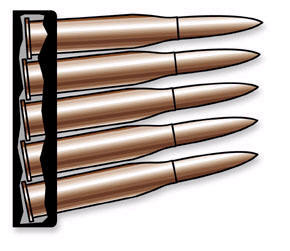
Back to the
top
Q5
My Bolt sticks after I fire a round, and
I
can hardly get the bolt open. What is this?
My
Bolt sticks after I fire a round, and
I
can hardly get the bolt open. What is this?
This is know
as "Sticky Bolt Syndrome" and is common in Mosin Nagants.
There are a couple of things that can cause this.
Failure to
clean the old cosmoline completely out of the chamber. All
it
takes is one small hard to see piece of dried cosmoline on the chamber
wall and it will "glue" the last round fired in place. The heat will
soften the cosmoline just enough and when the brass case expands in the
chamber it will glue that round right in. Opening the bolt and tapping
the bolt handle backwards with a rubber mallet till it releases is the
best way to open.. If that fails, you can get a wooden dowel
small enough to fit inside the opening of an empty brass case. stick it
down the barrel (muzzle end) and tap the
case out
with a small hammer. a good solid ramrod works or even the ramrod that
comes on it, but be careful not to mess up the crown (muzzle end).
The second
thing that can cause this (but much less likely) is steel
cased ammo with lacquer on them. Some of the older ammo that is steel
cased have this problem, but for the most part the new steel is OK.
Some old brass rounds are coated also. This lacquer (or clear coating)
has the same effect as the cosmoline above. So clearing it is the same.
When you get
those new Mosin Nagant rifles, take a 24 ga shotgun brass
brush to the chamber and clean it really good before taking it to the
range and you will not have the problems....usually! LOL
Back to the
top
Q6
Where is the
safety on my Mosin Nagant & how does it work?
Where is the
safety on my Mosin Nagant & how does it work?
Yes; with
the bolt closed, pull back on the bolt and rotate
counter-clockwise and release. Your rifle is now "safe".
First
place
the butt plate of the rifle in the crook of the elbow, then pull back
on the cocking piece and rotate it counter-clockwise about 45 degrees.
Removal
of the safety
Special care
should be taken when taking it off safe, as it is possible
to have an Accidental Discharge. Have the butt plate in the crook of
the elbow again, and be sure to have the muzzle pointed in a safe
direction. It's best to practice with a firearm you personally have
assured is UNLOADED.
While using
the safety, ALWAYS treat your firearm as though it does not
have a safety and is loaded.
Back to the
top
Q7
How
do I tell where my
rifle was made?
Arsenals
/ manufacturer that made
Mosins
You can "start" to find out where your rifle was made (if it is a
Russian made rifle) buy starting here
../new_owner_ID/index.html
More advanced study is needed on "un-common" rifles
Arsenals / manufacturer that made
Mosins (WWII
and earlier makers)
Russian
Arsenals:
Izhevsk (City
and commonly used) Izmash(Factory, less commonly
used)......pronounced "ee-ZHYEVSK", the“zh” sounds like “s”
http://www.merriam-webster.com/cgi-bin/audio.pl?ggizhe01.wav=Izhevsk
http://www.youtube.com/watch?v=KL7nCF_h7XA
Tula:
Sestroryetsk
......pronounced "syiss-trah-RYEHTSK"
First few
seconds of the video http://video.google.com/videoplay?docid=-3900411367538735432&ei=MJqESbD5J4SQqAKvwNjrCg&q=sestroretsk&hl=en#
US
Manufacturers:
Remington
New
England
Westinghouse
French
Arsenal:
Chatellerault
http://www.forvo.com/word/ch%C3%A2tellerault/
Finnish
Makers:
Tikkakoski
(Tikka)
VKT ( Valtion
Kivääritehdas or Valmet)
Sako
Arsenals
/ manufacturer that made
Mosins (Post
WWII)
Hungry
"02"
stamped on most parts
Poland
"circle
11" on the barrel shank and on many places
on the rifle;
China
Chinese writing on the barrel shank
Czechoslovakia
Made M91/38's from m91's. Looked like a
M91/59
or M38. Easy to spot as they have the old arsenal markings on the
barrel shank, but look like the newer carbines.
Romania
"Three "R"'s surrounded by
crossed stalks with leaves pointing outwards are on the top of the
breech."
Back to the
top
Q8
What does the "r"
stand for in 7.62x65r?
What does the "r" stand for after the date on the top of the barrel
shank?
What does the
"r"
stand for in 7.62x65r?
It
stands for "Rimmed". The ammunition
has
a rim at the base and sticks out just a little from the case.
What
does the "r" stand for after the date on the top of the barrel shank?
It
is the
Russian marking indicating "year"
Back to the
top
Q9
What does
counter bored mean?
Typically
when troops cleaned their rifles in
the field using the cleaning rod that came with it, they did a lot of
damage to the crown (the end of the barrel called the muzzle). Also
when the crown was "shot out" from many rounds going through the
barrel, the crown suffered also. When the crown is damaged the accuracy
will be lowered dramatically. To correct this damage you have to either
cut off the barrel and re-crown it, or replace the barrel. Another more
cost effective way is to counter boar the end of the barrel. In effect
putting a new crown on it deeper in the barrel where it is actually now
protected. The Russians and Finns did this to save money and to "fix
the problems".
Looking at
the photo below. Look down the barrel and you will see how
the bore has been machined open creating a new crown deeper in. This is
not a negative if you like to shoot. In fact it may shoot better after
doing so. It may be a bit of a minus for a collectible, but not that
bad.
The saying
is, "it's better to have a counter boared rifle, then one
that is not counter boared and the crown is bad."
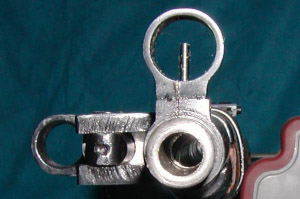
Back to the
top
Q10
What
measurements are the markings on the sights? (yards, meters, etc)
What
measurements are the markings on the
sights? (yards, meters, etc)
Short answer
is as follows:
(photos
below)
4, 6, 8, 10,
and 12 representing hundreds of arshini (a early Russian
measurement) Typical on M91 type Mosins
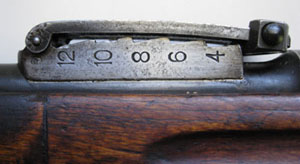 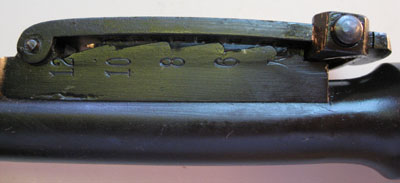
(photo below)
On M91/30
the graduations are on top of the leaf. 1 to 20 representing
hundreds of meters. Russians converted over to metric.
No Photo Yet!
(photo below
Finn
remarked their sights in meters. Typically they will have the
original Russian marks (arshini) on the opposite side (on some rifles)
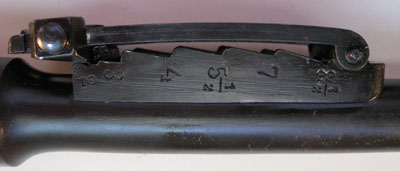
Later marked
Finn sights in meters (M28/30 and M39)
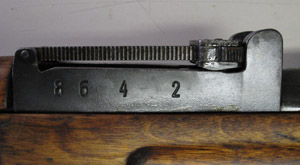 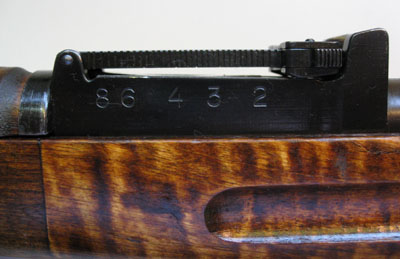
Back to the
top
Q11
What is force
matching?
When
a rifle was originally built
in Russia, all the serial #'s matched. Barrel shank, bolt, bottom of
magazine (door), and butt plate. Later after the rifle was refurbished
or parts replaced they "force marked" the replaced or mis matched
parts. Sometime they did this with stamps (sometimes the fonts don't
match) and sometimes they did it with an electric pencil. Most Finnish
rifles are force marked because they are a conglomeration of used
parts, reassembled into a working rifle. They wasted very little. Some
rifles are expected to be force matched, but the less it is done, the
more collectible it is.
Most refurbished Russian Mosin Nagants are force matched on the bolt a
the very least. Originally the letter prefix came on the bolt as well
as all the parts, but most refurbished rifles don't have the letter
prefix and only carry the numbers. The one's that do have the prefix
usually always have a miss matched font on the letters indicating the
bolt was changed at a latter date. It is expected and excepted on the
refurbished Mosin Nagants.
A rifle with all matching and original marks is harder to find and
raises the collectors value.
Back to the
top
Q12
Which way does
my sling go on?
Russian
Rifles with
"Dog Collars"

Finnish
Rifles with
"hangers"

Back to the
top
Q13
How do
you pronounce "Mosin
Nagant"?
How do you
pronounce "Mosin
Nagant"?
Place the
emphasis on bold syllables:
moye
seen nah gon
Back to the
top
Q14
How do I tell if my Mosin is an ex-sniper?
How
do I tell if my Mosin is an ex-sniper?
If you think
you may have a M91/30 ex PU sniper it is very easy
to tell. Open the bolt and look in the inside of the
receiver (see photo below)
When
these were taken out of service (for what ever
reason)
they were returned to duty as standard M91/30's and they did this
by inserting screws into the mount holes
and welding
them up on the outside and grinding them off.. So from the outside the
rifle looks normal, but from inside of the receiver you can see the
screws. (see below).
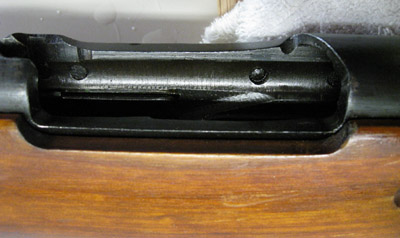
On a Izhevsk
rifle they didn't always remove the scope numbers from the
left side of the barrel shank, they just "lined them out". (see below)
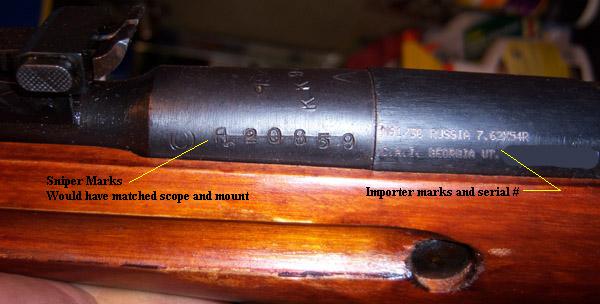
On a Tula
exsniper, on the top of the barrel shank is the large star
indicating manufacture in the Tula plant. Above that star are the
letters CN or CH, and that either indicates that at one time it was a
sniper or met sniper standards.
Sorry, not
photo yet.
Back to the
top
Q15
What is a "M44
Stock" on a M38 rifle? or What is the difference
between a M44 Stock and a M38 Stock?
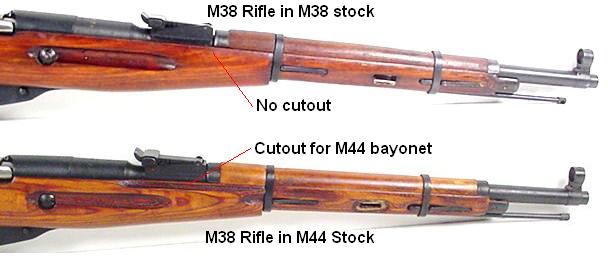
Back to the
top
Q16
What is the definition of Curios or Relics (C&R) firearms and
what
is an
antique firearm?
What
is
a Curio or Relics (C&R) firearm
Quote
from: ATF:
Firearms
which are of special interest to collectors by reason of some
quality other than is associated with firearms intended for sporting
use or as offensive or defensive weapons. To be recognized as curios or
relics, firearms must fall within one of the following categories:
(a) Firearms
which were
manufactured at least 50 years prior to the
current date, but not including replicas thereof;
(b) Firearms
which are certified
by the curator of a municipal, State,
or Federal museum which exhibits firearms to be curios or relics of
museum interest; and
(c) Any
other firearms which derive a substantial part of their
monetary value from the fact that they are novel, rare, bizarre, or
because of their association with some historical figure, period, or
event. Proof of qualification of a particular firearm under this
category may be established by evidence of present value and evidence
that like firearms are not available except as collector's items, or
that the value of like firearms available in ordinary commercial
channels is substantially less.
**********************************************************************
Note that if
a particular firearm was made 50 or more years ago, it
qualifies as a Relic per subparagraph (a) but that does not mean that
all firearms of a model year qualify.
For example,
not all Model 1894 Winchesters would qualify as a relic.
Only those actually made 50 or more years longer ago would be relics.
You would
have to see if a later made Model 1894 qualifies as a Curio
by checking the ATF Curios or Relics List.
This
is the
definition of an Antique Firearm:
Quote from:
ATF
(a) Any
firearm (including any firearm with a matchlock, flintlock,
percussion cap, or similar type of ignition system) manufactured in or
before 1898; and
(b) any
replica of any firearm described in paragraph
(a) of this definition if such replica
(1) is not
designed or
redesigned for using rim fire or conventional center fire fixed
ammunition, or
(2) uses rim
fire or conventional center fire fixed
ammunition which is no longer manufactured in the United States and
which is not readily available in the ordinary channels of commercial
trade.
As mentioned
above, the date the particular rifle was made is what
matters, not the model year. Thus a Mauser Model 98 made in 1898 would
be an antique; one made during WWI or WWII would not be an Antique but
would qualify as a Relic.
Back to the
top
Q17
What is a "bound book"?
What is a
"bound book"?
http://www.atf.gov/firearms/faq/faq2.htm#e1
A "bound
book" is a permanently bound book or an orderly arrangement of
loose-leaf pages which must be maintained on the business premises. The
format must follow that prescribed in the regulations, and the pages
must be numbered consecutively. [27 CFR 478.121 and 478.125]
*****************************************************
This is a
book that is kept by other FFL holders, but in our situation
when we are talking about a 03FFL license, it is a requirement to log
in and out all rifles purchased or sold into the book while you are a
holder of that license. It doesn't matter if you used your license to
purchase the rifle or not, it must be logged into or out of the book if
you are holding a 003FFL license at the time.
Back to the
top
Q18
How do you disassemble the bolt on a Mosin Nagant rifle, and reassemble
it?
How
do you disassemble the bolt (and put it back together)?
Please see
the "Disassembly and Cleaning
article" on the main
page
Back to the
top |
|
 |
|

